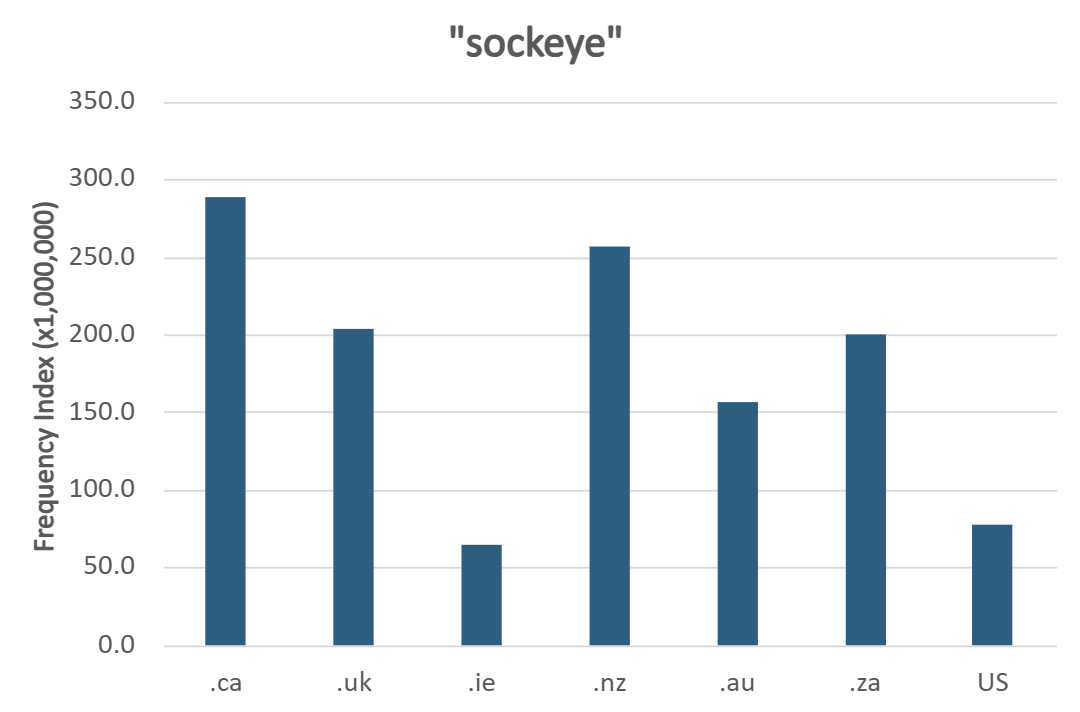Quick links
sockeye
< by folk etymology Coast Salish suk-kegh 'red fish'
DCHP-3 (Apr 2025)
n. — originally Indigenous
a species of Pacific salmon, Oncorhynchus nerka, of greenish blue and metallic green colour, with red, oily flesh valued as food.
Type: 1. Origin — The term originates in British Columbia or neighbouring territories as a loan-word from Coastal Salish.
The term is also a Type 4 Canadianism - Culturally Significant for its connection to First Nations peoples and the economic development of western Canada, which often happened on an exploitative scale (see, e.g., the 1879 quotation or the Government of Canada Publications link on recent salmon stock recovery measures).
As displayed in Chart 1, sockeye has also been popularized in New Zealand, as the species was introduced from British Columbia stock in 1902 (see the Scott (1984: 245) reference).
The term is included in COD-2, s.v. "sockeye", and is described as "a blue-backed salmon of the N American Pacific Coast"; Gage-5, s.v. "sockeye", locates it at "the coasts of British Columbia and Alaska". CCD-2010 considers red salmon a synonym: "WORD ORIGIN by folk etymology from Salishan sukkegh".
The term is included in OED-3, s.v. "sockeye", and described as "[t]he blueback salmon or nerka."; the term is not listed in EDD.
The term is listed in Merriam-Webster Unabridged, W-3 and DARE; in W-2 it is described as "sockeye salmon. [Coast Salish, suk-kegh.] The blueback salmon."
The term is also a Type 4 Canadianism - Culturally Significant for its connection to First Nations peoples and the economic development of western Canada, which often happened on an exploitative scale (see, e.g., the 1879 quotation or the Government of Canada Publications link on recent salmon stock recovery measures).
As displayed in Chart 1, sockeye has also been popularized in New Zealand, as the species was introduced from British Columbia stock in 1902 (see the Scott (1984: 245) reference).
The term is included in COD-2, s.v. "sockeye", and is described as "a blue-backed salmon of the N American Pacific Coast"; Gage-5, s.v. "sockeye", locates it at "the coasts of British Columbia and Alaska". CCD-2010 considers red salmon a synonym: "WORD ORIGIN by folk etymology from Salishan sukkegh".
The term is included in OED-3, s.v. "sockeye", and described as "[t]he blueback salmon or nerka."; the term is not listed in EDD.
The term is listed in Merriam-Webster Unabridged, W-3 and DARE; in W-2 it is described as "sockeye salmon. [Coast Salish, suk-kegh.] The blueback salmon."
Quotations
1869
The most important from the latter point of view, Is the Sockeye.
1879
The proprietors of canneries believe that they ought to be allowed to fish in the Harrison River. The present laws do not allow them to cast their nets above the tide water. The spawning grounds of the Sockeyes are far about the mount of the Harrison, in the streams which empty into the lake. This restriction in fishing, which was imposed by the Dominion Government without a due knowledge of facts, has, it is said, injured the cannery interest greatly during the present year.
1882
The only run to which the latter remarks of the Board apply is that of the sockeye, which generally continues from about the middle of July till well on towards the middle of August — sometimes shorter, sometimes longer.
1907
There is another smaller form of the sockeye salmon, found in many of the interior waters, that appears to be a permanently small form which is known to writers as "the little red fish."
1918
Fishermen and cannery men agreed that the indications are that the biggest salmon season in twenty years is before them.The sockeye and the humpback already have appeared in the Skoena, and some canneries have put up more than their entire pack last season.Many fishermen are cleaning up from forty to fifty dollars a day.
1932
Five runs of salmon; the Sockeyes in June (some even come in May), the Humpies in July, the Satchems in August and September, the Cohos in September and October, and the Dogs all through November and December.
1964
Sockeye salmon usually live to be four or five years of age. . . .
1978
ADAMS RIVER, B.C. — In quiet awe, the spectators line the baks of the turbulent, rocky Adams River to see the 1,500,000 sockeye salmon that have returned to the place where they were born to spawn and then die.
2008
"There's been three openings and there's been 100 sockeye each on average for fishermen for the total openings."
References
- OED-3
- Government of Canada Publications • Link
- Scott (1984)
- COD-2
- EDD
- W-2
- Gage-5
- DARE
- CCD-2010
- Merriam-Webster Unabridged
- W-3
Images
